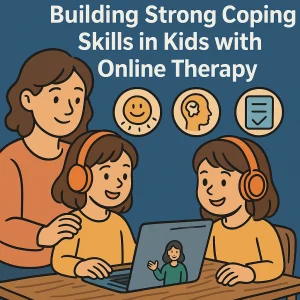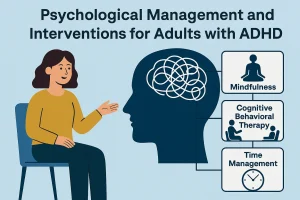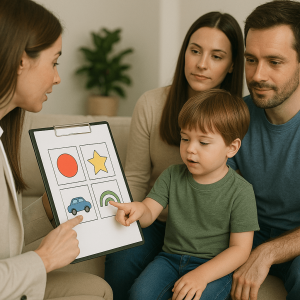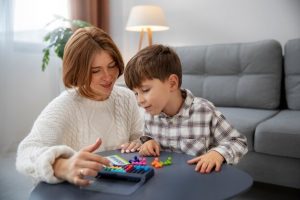How to Teach Mindfulness to Kids in Online Sessions
Last Updated: August 23, 2024
In today’s fast-paced world, teaching mindfulness to kids is more important than ever. Mindfulness, the practice of being fully present in the moment, helps children develop emotional resilience, improve focus, and reduce stress. For parents and educators, it offers a powerful tool to nurture a child’s well-being, equipping them with the skills they need to navigate life’s challenges with calm and confidence.
But with the shift to online learning, you might wonder how to effectively teach mindfulness through a screen. The challenges are real—maintaining engagement, managing distractions, and creating a sense of connection in a virtual environment can be tricky. However, the opportunities are equally significant. Online platforms offer unique ways to incorporate interactive and fun mindfulness activities that can captivate and resonate with kids.
Also Read: Simple Mindfulness Techniques to Reduce Distractions in Kids
Understanding Mindfulness for Kids
Mindfulness, at its core, is the practice of paying full attention to the present moment. For kids, this can mean simply noticing what they’re feeling, seeing, or hearing right now, without getting distracted by what happened yesterday or what might happen tomorrow. It’s like pressing a pause button in their busy minds, allowing them to focus on the “now.”
Teaching mindfulness to kids is not just about helping them stay calm; it’s about giving them the tools to navigate their emotions, focus better, and respond to challenges with a clear mind. For example, a simple mindfulness exercise for kids might involve deep breathing or paying attention to the sounds around them. These exercises help children develop a stronger sense of self-awareness, which in turn improves their ability to focus on tasks, manage their emotions, and handle stress effectively.
In a virtual mindfulness session for kids, these benefits are even more valuable. With the shift to online learning, children are spending more time in front of screens, which can sometimes make it harder to stay focused and calm. Incorporating mindfulness into their daily routine can help counteract these challenges. Mindfulness exercises can serve as a much-needed break from the screen, helping kids reset and re-engage with their learning activities.
Also read: Growing Impact of Online Social Emotional Learning on Schools
Setting Up for Successful Online Mindfulness Sessions
Creating a calm and focused environment at home is essential for making your child’s online mindfulness training both effective and enjoyable. When kids have a dedicated space where they can practice mindfulness, they are more likely to feel relaxed and engaged during their digital mindfulness lessons. Here are some simple tips to help you set up the perfect environment:
1. Personalize the Space
Allow your child to personalize their mindfulness space with items that make them feel happy and secure. This could include their favorite blanket, a beloved stuffed animal, or even some of their artwork. When children feel a connection to their environment, they are more likely to fully engage in their mindfulness practice.
2. Designate a “Mindfulness Space”
Choose a quiet area in your home where your child can practice mindfulness without distractions. This space doesn’t need to be large—just a spot where they can feel safe and undisturbed. It could be a corner of their bedroom, a spot in the living room, or even a small nook in the garden. The key is to make this area their special place for mindfulness, where they can retreat whenever they need a moment of calm.
3. Create a Comfortable Setting
Comfort is important for mindfulness. Make sure your child has comfortable seating, like a soft cushion, bean bag, or chair, where they can sit comfortably during their sessions. The goal is to help them relax and focus on their mindfulness practice without feeling restless or uncomfortable.
4. Add Calming Elements
Enhance the mindfulness space with calming elements. Soft, natural lighting or a small lamp can create a soothing atmosphere. Adding a few plants can promote a sense of peace and well-being. You can also play gentle background music or nature sounds to help your child settle into their mindfulness practice. There are many playlists and apps available that offer calming music specifically for mindfulness and meditation.
5. Minimize Distractions
To get the most out of online mindfulness lessons, it’s important to minimize distractions. Turn off any nearby devices, close doors to reduce noise, and encourage other family members to respect this quiet time. If your child is using a tablet or computer for their mindfulness session, make sure notifications are turned off to prevent interruptions.
Engaging Mindfulness Activities for Kids Online
Engaging kids in mindfulness activities during online sessions can be both fun and effective. By incorporating interactive and age-appropriate exercises, you can make mindfulness something that children look forward to and benefit from. Here’s a step-by-step guide to teaching mindfulness to kids online, featuring simple activities that can help them focus, relax, and connect with their inner selves.
1. Mindful Breathing
One of the most effective online techniques for teaching mindfulness to young kids is through mindful breathing exercises. These exercises are easy to follow and can be done anywhere, making them perfect for virtual sessions.
- Belly Breathing: Teach kids to place their hands on their bellies and take slow, deep breaths. As they breathe in, their bellies should rise like a balloon, and as they breathe out, their bellies should fall. This simple exercise helps children focus on their breathing and brings a sense of calm. You can guide them through a few rounds, encouraging them to notice how their bodies feel with each breath.
- Teddy Bear Breath: For younger children, make it more interactive by having them lie down and place a teddy bear on their belly. As they breathe in and out, they can watch the teddy bear rise and fall, which makes the exercise more engaging and helps them concentrate on their breath.
2. Mindful Listening
Encourage kids to use their “Spidey Senses” to engage in mindful listening. This activity is designed to heighten their awareness of the sounds around them, fostering a deeper connection to the present moment.
- Ask the children to sit quietly and close their eyes, pretending they are superheroes like Spider-Man, using their super senses to detect sounds. Guide them to focus on all the different sounds they can hear—maybe the hum of a fan, birds chirping outside, or even their own breathing. This exercise helps sharpen their focus and can be a fun way to introduce mindfulness.
3. Gratitude Practice
Incorporating a gratitude practice into online mindfulness sessions can significantly enhance children’s emotional well-being. A simple and creative way to do this is by creating a “Gratitude Sun.”
- Gratitude Sun: At the beginning of each session, ask the children to think of one thing they are grateful for and write it down or draw it on a ray of a sun. Over time, they can build a sun with rays filled with positive thoughts and things they appreciate. This activity not only starts the session on a positive note but also teaches kids the importance of focusing on the good things in life, which can be especially valuable during stressful times.
4. Mindful Posing
Mindful posing is a great way to engage kids physically and mentally. It combines movement with mindfulness, helping children feel strong, grounded, and present.
- Superman Pose: Have the kids stand with their feet slightly wider than their hips, clench their fists, and stretch their arms up to the sky like they’re flying. This pose helps them feel powerful and confident.
- Wonder Woman Pose: Another option is the Wonder Woman pose, where kids stand tall with their legs apart and hands on their hips. This stance can help them feel brave and ready to tackle any challenges that come their way.
Incorporating Mindfulness into Daily Routines
To truly benefit from mindfulness, it’s important to weave it into your child’s daily life, not just during scheduled sessions but throughout the day. You might be wondering, What are the best online methods to teach mindfulness to kids? or How can I teach mindfulness to my child through online sessions? The key lies in making mindfulness a consistent and natural part of your child’s routine, transforming everyday activities into mindful moments.
1. Mindful Eating
Mindful eating is a simple yet powerful way to incorporate mindfulness into daily life. During meals or snacks, encourage your child to pay close attention to the flavors, textures, and smells of their food. Ask them to take small bites and chew slowly, really noticing how the food feels in their mouth and how it makes them feel. This practice not only enhances their eating experience but also teaches them to appreciate the present moment, one bite at a time.
2. Mindful Walking
Another great way to practice mindfulness is through mindful walking. Whether it’s a walk around the house, in the garden, or during a stroll outside, guide your child to focus on each step they take. Encourage them to notice how their feet feel as they touch the ground, the rhythm of their breathing, and the sights and sounds around them. Mindful walking is a wonderful way to help kids stay grounded and connected to their environment, even during simple daily routines.
3. Bedtime Routines
Bedtime is an ideal opportunity to integrate mindfulness into your child’s day. As part of their nightly routine, introduce a short mindfulness exercise, such as deep breathing or a body scan. You can guide them to lie down, close their eyes, and slowly breathe in and out, focusing on relaxing each part of their body, from their toes to their head. This not only helps them wind down but also promotes a restful night’s sleep.
4. Consistency is Key
While incorporating mindfulness into various activities is beneficial, the real impact comes from consistency. Encourage your child to practice mindfulness every day, even if it’s just for a few minutes. By making mindfulness a regular part of their routine, it becomes a habit that they can rely on to manage stress, improve focus, and enhance their overall well-being.
Daily Mindfulness Routine Suggestions
| Time of Day | Activity | Purpose |
|---|---|---|
| Morning | 5-Minute Deep Breathing | – Begin the day with a sense of calm and focus. – Helps children prepare mentally for the day ahead. – Encourages a positive and peaceful start to the day. |
| Lunchtime | Mindful Eating | – Enhance awareness and appreciation of food. – Encourage children to notice textures, flavors, and smells, fostering a mindful eating habit. – Helps in developing a healthier relationship with food. |
| Afternoon | Mindful Walking | – Connect with the environment, reduce stress. – Encourage children to pay attention to their surroundings, such as sounds, sights, and the sensation of walking. – Provides a break from screen time and promotes physical activity. |
| Evening | Gratitude Practice | – Reflect on positive aspects of the day. – Encourage children to think of things they are grateful for, fostering a positive mindset. – Helps children wind down and develop a habit of looking for the good in each day. |
| Bedtime | Body Scan Meditation | – Relaxation and preparation for restful sleep. – Guide children through a body scan, helping them relax each part of their body. – Promotes a deep and restful sleep by easing tension and calming the mind. |
Overcoming Challenges in Online Mindfulness Sessions
Teaching mindfulness to children online comes with its own set of challenges. Maintaining engagement, dealing with technical issues, and ensuring active participation are common hurdles that can make online mindfulness sessions feel less effective. However, with the right strategies, these challenges can be successfully managed, creating a positive and impactful experience for children.
1. Maintaining Engagement
One of the biggest challenges in child-focused mindfulness online sessions is keeping children engaged. Unlike in-person sessions, where physical presence naturally commands attention, online sessions can lead to distractions. To combat this, it’s important to keep sessions short and interactive.
- Short and Focused Sessions: Children have limited attention spans, especially in an online environment. Keep each mindfulness activity brief—around 5 to 10 minutes—and break up longer sessions with interactive elements like games or short discussions. This approach ensures that children stay engaged without feeling overwhelmed.
- Interactive Tools: Utilize interactive tools such as virtual whiteboards, drawing applications, or screen-sharing features to make the session more dynamic. For example, you can have children draw how they’re feeling on a virtual whiteboard or share their favorite mindfulness practice. These tools not only maintain engagement but also encourage active participation.
2. Dealing with Technical Issues
Technical glitches are an inevitable part of online sessions. These can range from poor internet connections to software malfunctions, all of which can disrupt the flow of a mindfulness session.
- Preparation and Flexibility: Before each session, ensure that your technology is functioning properly and have a backup plan in case issues arise. For instance, if a video call fails, be ready to switch to an audio call or have a mindfulness audio recording that children can listen to while the issue is resolved. Flexibility is key—being adaptable in the face of technical difficulties helps maintain a calm and positive atmosphere.
- Clear Instructions: Provide clear instructions to both parents and children on how to use the online platform before the session begins. This can minimize confusion and reduce the time spent troubleshooting during the session itself. You can also create a simple guide or video tutorial to help them navigate common issues.
3. Ensuring Active Participation
In an online setting, it can be challenging to gauge whether children are actively participating or merely watching passively. Encouraging active participation is crucial for making the mindfulness exercises effective.
- Social Interaction and Sharing: Incorporate opportunities for children to share their thoughts and experiences during the session. For example, after a mindfulness activity, you can ask each child to share how they felt or what they noticed. This not only fosters a sense of community but also ensures that each child is actively engaged.
- Personalized Attention: If possible, try to give personalized attention to each child during the session. Calling them by name and asking direct questions can make them feel more involved and less likely to zone out.
The Role of Parents and Educators in Supporting Mindfulness
When it comes to teaching mindfulness to children, the role of parents and educators is pivotal. Their involvement and guidance can significantly enhance the effectiveness of mindfulness practices, especially in an online setting. By modeling mindfulness behavior and integrating mindfulness into daily routines, both at home and in virtual classrooms, they can help children develop these valuable skills for life.
1. Parental Involvement and Modeling Mindfulness
Parents play a crucial role in fostering mindfulness in their children. One of the best practices for mindfulness sessions with children over video is for parents to actively participate alongside their kids. When children see their parents engaging in mindfulness activities, they are more likely to follow suit. Modeling calm and present behavior can help children understand the value of mindfulness in managing emotions and staying focused.
- Practice Together: Encourage parents to join their children during mindfulness sessions, whether it’s a guided breathing exercise, mindful eating, or a gratitude practice. This shared experience not only strengthens the parent-child bond but also reinforces the habit of mindfulness in everyday life.
- Consistency at Home: Parents can integrate mindfulness into daily routines, such as during meals, bedtime, or even while taking a walk. By consistently practicing mindfulness, parents demonstrate its importance and make it a natural part of the child’s day.
2. Educators Incorporating Mindfulness into Virtual Classrooms
Educators have the unique opportunity to bring mindfulness into the virtual classroom, making it an integral part of the curriculum. Incorporating mindfulness into daily routines during online classes can help students manage stress, improve focus, and create a more positive learning environment.
- Daily Mindfulness Moments: Teachers can start each class with a short mindfulness activity, such as deep breathing or a moment of silence. These small practices can set a calm tone for the lesson and help students transition into a focused learning state.
- Interactive Mindfulness Exercises: Engaging students in interactive mindfulness activities, such as mindful listening or guided visualization, can make mindfulness a fun and regular part of online learning. These activities not only enhance the learning experience but also equip students with tools to manage their emotions and attention throughout the day.
3. Wellness Hub’s Support for Parents and Educators
At Wellness Hub, we understand the importance of integrating mindfulness into children’s lives, whether at home or in school. We offer a range of resources and support for both parents and educators looking to incorporate mindfulness into their routines.
- For Parents: Wellness Hub provides guidance on how to practice mindfulness with your child at home, with easy-to-follow tips and activities that fit seamlessly into daily life. By visiting our Wellness Hub Parenting Resources, parents can find valuable information on fostering mindfulness in their children.
- For Educators: We offer tools and strategies for educators to integrate mindfulness into their virtual classrooms. Our resources are designed to help teachers create a more mindful learning environment, supporting students’ mental and emotional well-being.
Conclusion
Teaching mindfulness to kids in online sessions can be a simple and effective way to support their emotional and mental well-being. In this article, we’ve covered key steps on how to teach mindfulness to kids in online sessions, including creating a calm environment, using engaging activities, and handling common challenges. By making mindfulness a regular part of their routine, you can help children learn to manage stress, focus better, and develop emotional resilience that will benefit them throughout their lives.
As you start incorporating mindfulness into your online sessions, remember that consistency is important. Even small steps can make a big difference over time. If you’re looking for more guidance, Wellness Hub offers a variety of resources to help you introduce mindfulness at home or in a virtual classroom. Visit Wellness Hub to explore more tips and tools that can support you in making mindfulness a positive part of your child’s life.
Frequently Asked Questions:
1. What is the best way to teach mindfulness to kids online?
The best way to teach mindfulness to kids online is by creating a calm and focused environment, using engaging activities like mindful breathing and listening, and keeping sessions short and interactive. Consistency in practice is key to helping kids develop mindfulness skills.
2. How can I incorporate mindfulness into my child’s daily routine?
You can incorporate mindfulness into your child’s daily routine by integrating it into activities like mindful eating, mindful walking, and bedtime routines. Simple practices, such as deep breathing before bed or focusing on the senses during a walk, can make mindfulness a natural part of their day.
3. What are some effective online mindfulness activities for children?
Effective online mindfulness activities for children include belly breathing, using “Spidey Senses” for mindful listening, gratitude practices like creating a “Gratitude Sun,” and fun poses such as the Superman or Wonder Woman pose. These activities are engaging and easy to follow during online sessions.
4. How can parents support their children in practicing mindfulness at home?
Parents can support their children by modeling mindfulness behavior, practicing mindfulness together, and making it a regular part of the daily routine. Parents can also create a dedicated mindfulness space at home where their child can practice without distractions.
5. What tools and resources can help with teaching mindfulness to kids online?
There are several tools and resources available, such as mindfulness apps like Smiling Mind and Headspace for Kids, YouTube channels like Cosmic Kids Yoga, and guided meditation audios from sources like New Horizons Meditation for Kids. These resources can enhance online mindfulness sessions and make the practice more engaging for children.
6. Why is consistency important in teaching mindfulness to children?
Consistency is important because it helps children develop mindfulness as a habit. Regular practice allows kids to better manage stress, improve focus, and build emotional resilience. Consistent mindfulness practice leads to long-term benefits for their overall well-being.
7. How can educators incorporate mindfulness into virtual classrooms?
Educators can incorporate mindfulness into virtual classrooms by starting each session with a short mindfulness activity, using interactive tools to keep students engaged, and making mindfulness a regular part of the curriculum. Activities like deep breathing, guided visualizations, and mindful listening can be easily integrated into online lessons.
8. Where can I find more resources on teaching mindfulness to children?
You can find more resources on teaching mindfulness to children at Wellness Hub, where we offer tips, tools, and guidance for parents and educators looking to integrate mindfulness into their children’s lives. Wellness Hub provides a variety of resources tailored to both home and virtual classroom settings.
9. How can I keep my child engaged during online mindfulness sessions?
To keep your child engaged during online mindfulness sessions, use interactive tools like virtual whiteboards, incorporate fun activities such as mindful posing, and keep the sessions short and focused. Allowing time for sharing and social interaction can also help maintain their interest and participation.
10. What are the long-term benefits of teaching mindfulness to kids?
The long-term benefits of teaching mindfulness to kids include improved focus, better emotional regulation, reduced stress, and increased resilience. These skills not only help children navigate challenges in the present but also set the foundation for healthier mental and emotional well-being as they grow older.
About Author:
Lasya Vooturi,
Clinical Psychologist (A) & Behavioral Therapist
Lasya holds a Professional Diploma in Clinical Psychology from Amity University, where she deepened her understanding of psychological principles from March 2023 to March 2024. With over a year of dedicated experience as a Behavioral Therapist, Lasya has honed her skills in applying effective therapy techniques tailored to individual needs. Fluent in Telugu, Hindi, and English, she is adept at connecting with a diverse range of clients, ensuring comprehensive communication and understanding. Lasya’s approach is grounded in empathy and scientific rigor, making her a trusted ally in navigating mental health challenges.
Book your Free Consultation Today
Parent/Caregiver Info:
Client’s Details:
* Error Message








